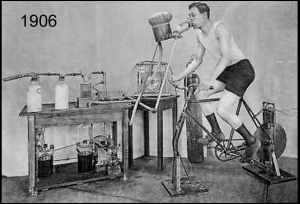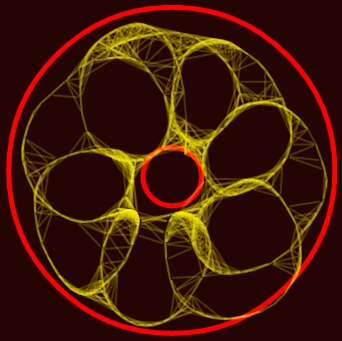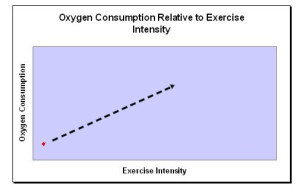Life in the Cell Begins at the Edge of Death, Part 3
Part 3: Speak in no Uncertain Terms – Define Aerobic Metabolism Concretely
The phrase, “aerobic metabolism occurs in the presence of oxygen” describes the role of oxygen as if it is a ‘bystander’ or non-participating element during the process of combustion.
 O2 is not just present within your body during metabolism; oxygen is simply the element that continually combines with fuel.
O2 is not just present within your body during metabolism; oxygen is simply the element that continually combines with fuel.
Metabolism = Fuel + O2 = Fire.
Aerobic metabolism is just a another form of combustion – just less hot and less explosive compared to burning coal or wood. From here on forward, take it literally the words “combustion of fuel” – “combining fuel with O2” or “aerobic metabolism” all mean the same thing.
Now consider the ‘1906 Man on Bike’ combustion experiment.
While just sitting on the bike – not pedaling – all the cells of the man burning acetic acid do so at their resting or ‘idle’ rate. But while pedaling, the exercise increases the rate of combining fuel and oxygen in his leg cells.
The words “increase of exercise intensity” present a ‘what comes first, the chicken or egg?’ situation:
- Exercise does not cause the man to increase his usage of fuel and oxygen (or even calories). It’s the other way around, stated below:
- The increased rate of combustion in his muscle cells increased his exercise intensity.
In short, combining fuel and oxygen quicker = ‘more fuel + O2 explosions’. Moving muscles do not cause the explosions, explosive combustion causes the movement. Increasing the rate of combustion within muscle cells in a given time frame increases what we see physically as exercise intensity and speed.
Here’s a concrete, natural example of how increasing the rate of combustion causes the increase of power and heat output:
- Blowing onto a tiny bonfire to get it going – feeds it more oxygen. Blowing forces more O2 ‘into the wood’ and makes it flame up and burn hotter – and so the fuel (wood) combines faster with extra oxygen you give it.
- Blowing into a fire is equivalent to your muscle cells combining oxygen with acetic acid faster from the baseline rate at rest – thus, your exercise intensity increases from ‘rest speed‘ to faster speeds.
Before going any further again, it is important to think your cells work at ‘rest speed’ – just as a car engine runs when combining fuel and oxygen at idle. While sitting – you’re idling – still using oxygen and fuel.
The red dot in the graph depicts how much oxygen is used during the ‘idle’ or resting state. The arrow shows the progressive increase of oxygen combining with fuel – as exercise intensity increases.
Main Points:
- At rest, your cells are always idling – burning fuel like a pilot light on a furnace – lighted and always ready to increase combusting fuel when you ‘turn up the heat’.
- Faster movement and more heat are made only by increasing combustion. Past your idling rate, increasing combustion in your body is: more Fuel + more O2 –> more Heat + more CO2 + more Water + Movement.
- Cars, trains, planes all move as result of combusting fuel. You see?… movement is the result of combustion.
So what ultimately causes your muscle cells to increase the combustion reaction rate? In essence, your thought and willpower alone; YOU control the rate your cells ‘eat’ or combust fuel. Sit, and you combust fuel slowly – decide to speed up, and you increase combustion within.
Next, Part 4: Reinterpreting Oxygen Consumption


